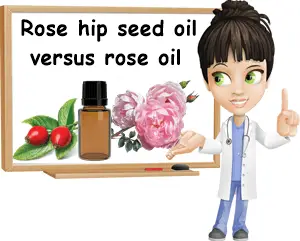Despite the similarity in name, rose hip oil and rose oil are two very different products, with very different properties. But what is the difference between them? There are actually a lot of differences between rose hip and rose oil, starting with composition, scent or lack thereof, production method, edibility and toxicity, conditions of use and side effects.
Find out what are rose hip and rose oil, how they’re made and meant to be used, which is an essential and which is a carrier oil and more interesting facts about why they are different from one another.
What is rose hip oil?
Rose hip oil, also spelled rosehip, is an oil extracted from rose hips seeds. Rose hips are the fruits of the rose plant and are also called rose heps, haws or simply hips. They are used to make tea, natural vitamin C supplements and a cosmetic oil used for hair and skin care. Because the fruit seeds are the source of the oil, rose hip oil is actually rose hip seed oil. Products labeled as rose hip seed oil are typically high-purity, while those labeled simply as rose hip oil may or may not be high-purity.

What is rose oil?
Rose oil, or more exactly rose essential oil, is an aromatic oil made from rose petals. Rose oil is usually extracted from the flowers of cultivated rose species, whereas rose hip oil is more commonly extracted from the seeds of wild rose plants. Cultivated and wild roses are essentially different variants of the same plant: the rose.
Cultivated roses also produce fruits or rose hips, but because they produce bigger, richer and more fragrant flowers, they are preferred for the production of rose oil.
Whereas wild rose species, which have less showy flowers, are preferred for their fruit and seeds from which jams, tea, soup and rose hip oil are produced.
How is rose hip oil made?
Rose hip oil is a cold pressed seed oil, meaning it’s made from seeds and cold-pressed. In other words, it is extracted mechanically, without heat, solvents or the use of any method or product that could potentially denature the natural properties or qualities of the oil. Rose hip oil is made by removing the tiny seeds from the fruits, cleaning the excess pulp and hairs off the seeds, then crushing them to extract the natural oils.
It is typically made from the seeds of wild rose plants. Preferred species for oil production include Rosa canina, Rosa rubiginosa and Rosa moschata, but the oil can be made from virtually any rose species with edible, aka non-toxic, fruit (examples: R. virginiana, R. arkansana, R. arvensis, R. blanda, R. rugosa, R. californica, R. carolina, R. gallica, R. moyesii etc.).
How is rose oil made?
Rose oil is made from rose petals. Because of their bigger blooms, higher petal count and stronger fragrance, selected cultivated rose species are used for oil production. In the case of rose oil, the aim is to extract the fragrance from the flower petals, whereas in the case of rose hip oil the aim is to extract the fatty acids/natural oils in the seeds. Rose oil obtained by steam distillation is known rose otto or attar of roses (the water remaining after the distillation process is marketed as rose water and is used both in cosmetics and food flavoring).
Rose oil obtained by solvent extraction is known as rose absolute and is more fragrant than the first. The Damask rose, Rosa damascena, and the cabbage rose or the hundred-petaled rose, Rosa centifolia, are two preferred species for rose oil production.

Is rose hip a carrier or essential oil?
Rose hip oil is a carrier oil. What this means is that it’s used as a base, to dilute aromatic essential oils before use on the skin. While it’s not technically inedible (it’s made of fats and some vitamins and antioxidants), it’s best not eaten like other vegetable oils.
Being a carrier oil, rose hip can be used safely on the skin, without prior dilution.
Because it is a seed oil, it is rich in fatty acids such as Omega-6, Omega-3 and saturated fatty acids such as palmitic and stearic acid which contribute to skin nutrition and have a moisturizing, emollient action.
Vitamin E and plant-based vitamin A (pro-vitamin A antioxidants such as beta-carotene) further account for the benefits of the oil and its safety when used for skin care. See the benefits of rose hip oil.
Is rose oil a carrier or essential oil?
Rose oil is an essential oil. It’s a type of highly fragrant oil, meaning it concentrates the aromatic compounds in the flower petals.
Aromatic compounds are normally very irritant in high concentrations, which means that the oil is also irritating and needs to be diluted before use on the skin (with a carrier oil such as rose hip or coconut). Only with dilution is it safe to use for skin care.
The volatile and aromatic organic compounds that give rose oil its unique and strong fragrance also make it inedible.
Ingesting essential oils is toxic and can prove fatal. Rose water, the by-product of rose oil production through steam distillation, is used in both cosmetics and as a food flavoring agent in limited amounts.
Rose hip vs rose oil differences
- Rose hip oil is not technically inedible, but best not eaten, while rose oil is inedible and toxic.
- Rose hip oil is made from seeds, while rose oil is made from flower petals.
- Rose hip oil is extracted through cold pressing, while rose oil through steam distillation and solvent extraction.
- Rose hip oil is made from wild rose species, while rose oil is made predominantly from cultivated rose species.
- Rose hip oil is a carrier oil, vs rose oil which is an aromatic or essential oil.
- Rose hip oil can be used on the skin undiluted, vs rose oil which requires dilution prior to use on the skin.
- Rose hip oil is relatively safe to use topically, vs rose oil which can cause irritation, contact dermatitis, photosensitivity and even liver toxicity.
- Rose hip oil is light amber in color, with faint orange reflexes, while rose oil is very light yellow (rose attar, obtained through distillation) or a deep, red-brown (rose absolute, obtained through solvent extraction).
- Rose hip oil has a faint earthy, oily odor, but no perfume; rose oil is fragrant, reminiscent of roses.
- Rose hip oil is rich in fatty acids and fat-soluble vitamins (Omega-6, Omega-3, stearic and palmitic acids, vitamins A and E); vs rose oil which is rich in volatile and aromatic compounds (beta-damascenone, beta-damascone, beta-ionone, rose oxide, citronellol, geraniol, nerol, linalool, limonene, eugenol etc.).
- Rose hip oil gets absorbed in the skin, vs rose oil which evaporates or dissipates upon contact with the skin.
- Rose hip oil can be used directly on the skin, vs rose oil which needs to be added to a base so it doesn’t irritate the skin or make it overly sensitive to light.
Rose hip vs rose oil uses
Both rose hip and rose oil boast mainly cosmetic uses, being employed for hair and especially skin care.
However, the difference between the two is that rose hip oil can be used as it is on the skin and hair (undiluted), whereas rose oil needs to be diluted with a carrier or base oil prior to use because it’s too strong and can cause side effects such as contact dermatitis, skin redness, burns or sensitivity to light, even liver toxicity. Because of its fragrance, rose oil is further used in aromatherapy (also diluted) and perfume-making. Neither product is meant to be used internally, only topically.
Both can cause allergic reactions with the potential for anaphylactic shock, which warrants caution with regards to their use.
